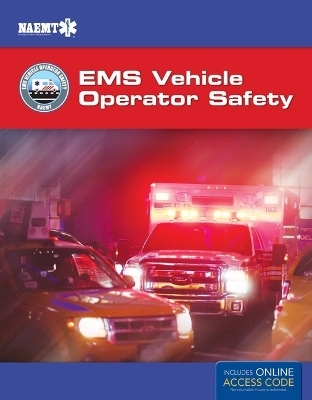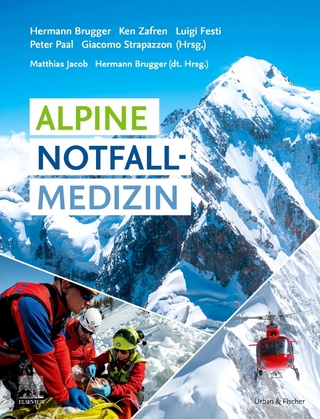
EVOS: EMS Vehicle Operator Safety
Jones and Bartlett Publishers, Inc (Verlag)
978-0-7637-8167-5 (ISBN)
- Lieferbar
- Versandkostenfrei
- Auch auf Rechnung
- Artikel merken
EMS Vehicle Operator Safety (EVOS) addresses the vehicle operations and transport safety knowledge gaps that lead to injury and death. Built on current research and featuring discussions of actual crashes and common driving scenarios—and the lessons that can be learned from them— it challenges emergency vehicle operators to consider if they truly know how to arrive at a scene safely. The course manual profiles real-life incidents and provides practical safety pointers, emphasizing the critical safety principles that are needed to transform a culture of dangerous driving habits into a culture of safety.
Promoting a Culture of Safety
EMS Vehicle Operator Safety trains EMS providers to recognize the specific behaviors that must be changed in order to promote a culture of safe driving. Participants are taught to identify and remove hazards that lead to vehicle collisions, from sleep deprivation to technological distractions to alcohol and substance use. Participants learn practical strategies to reduce the risk of a collision, from defensive driving to vehicle positioning to use of lights and siren. The course also underscores the significance of local laws and regulations that govern EMS vehicle operation, and how standard operating procedures (SOPs) are central to shaping safe driver behavior.
The program addresses:
Developing a safety-first attitude to ensure the emergency vehicle operator’s own safety and the safety of his or her partner, the patient, and any passengers
Distinguishing the types of laws that affect EMS vehicle operation, including considerations for responding to emergency and non-emergency calls
Taking appropriate precautions when performing specific vehicle maneuvers and when driving under various road and weather conditions
Performing daily vehicle inspections to manage mechanical issues
Practicing mental, emotional, and physical preparedness
Responding appropriately and safely to emergency responses
Proactively avoiding vehicle crashes and how to respond if one occurs
Developing spatial awareness and practicing skill maneuvers in a driving skills course
Evaluating new and future developments in EMS technology
Utilizing simulation training to integrate knowledge learned during lectures with the technical abilities and judgment acquired through skills practice
Developing effective agency SOPs for key aspects of EMS vehicle operation
Bob has been involved in EMS since 1975. He is a full time clinical instructor for Albany Medical Center working in the Hudson Valley Community College Paramedic Program. He is also a paramedic with the Town of Colonie EMS Department, Times Union Center, and Whiteface Mountain Medical Services. He has served as National and Regional Faculty for the AHA, and Regional Faculty for the NYS Bureau of EMS. He also has served as a paramedic and lieutenant for NYC EMS, a Paramedic Program Director, Associate Director of the NYS EMS Bureau, and the Education Coordinator for PULSE: Emergency Medical Update.'He is an author/coauthor of these Jones and Bartlett/AAOS books: Paramedic: Anatomy and Physiology, Paramedic: Pathophysiology, Paramedic: Pharmacology, Paramedic Field Guide, Student Workbook for Emergency Care in the Streets, and Editor of Nancy Caroline's Emergency Care in the Streets.'Bob was also a co-author of the National First Responder, Paramedic and EMT-Intermediate curricula, the 2007 Paramedic Practice Guidelines, as well as a co-author of the AHA Guidelines 2005 which have paved the way to improving successful resuscitation of cardiac arrest.' He is an AHA Board member and a passionate advocate for strengthening the links in the chain of survival. Robert Raheb has been in the EMS field for over 30 years and spent 10 years in a leadership role with the Emergency Vehicle Operator Course program. He has achieved a high degree of success after adapting the New York City Fire Department Bureau of EMS (FDNY EMS) curriculum to include simulation training, which has translated into a 50% reduction in intersection collisions. He is currently the Emergency Response Training Specialist at FAAC, Incorporated. Mr. Raheb has served as a member of the Congressional Fire Service Institute, National Association of EMS Educators, and the International Society of Fire Service Instructors, and currently serves on the Fire Service Training committee for the NFPA. In addition, Mr. Raheb writes for national publications and conducts several speaking presentations each year. Formed in 1975 and more than 32,000 members strong, the National Association of Emergency Medical Technicians (NAEMT) is the nation’s only organization solely dedicated to representing the professional interests of all EMS practitioners, including paramedics, emergency medical technicians, emergency medical responders and other professionals working in prehospital emergency medicine. NAEMT members work in all sectors of EMS, including government service agencies, fire departments, hospital-based ambulance services, private companies, industrial and special operations settings, and in the military. NAEMT represents all EMS practitioners in promoting: • Greater understanding and appreciation by government agencies at the local, state and national levels of the role that EMS plays in our nation's health care, public safety, and disaster response systems. • Pay and benefits that reflects their professional training, responsibilities and dedication. • Leadership at the federal level that fosters and supports the delivery of quality EMS nationwide. • Adequate and sustainable funding for EMS in all locations. • Public policy that supports EMS practitioners and the patients they serve.
| Erscheint lt. Verlag | 17.10.2016 |
|---|---|
| Verlagsort | Sudbury |
| Sprache | englisch |
| Gewicht | 284 g |
| Themenwelt | Medizin / Pharmazie ► Medizinische Fachgebiete ► Notfallmedizin |
| Wirtschaft | |
| ISBN-10 | 0-7637-8167-3 / 0763781673 |
| ISBN-13 | 978-0-7637-8167-5 / 9780763781675 |
| Zustand | Neuware |
| Informationen gemäß Produktsicherheitsverordnung (GPSR) | |
| Haben Sie eine Frage zum Produkt? |
aus dem Bereich



